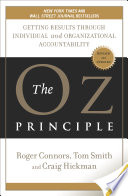

The core premise of 'The Oz Principle' is the concept of personal accountability. The authors argue that individuals must take responsibility for their actions and outcomes rather than blaming external circumstances. This principle is illustrated through the metaphor of the characters from 'The Wizard of Oz,' who each embark on a journey of self-discovery. The book emphasizes that accountability is a choice, and it leads to empowerment. By acknowledging their role in their circumstances, individuals can begin to change their environments and outcomes. The authors provide practical strategies for fostering accountability, including setting clear expectations, creating a culture of honesty, and encouraging open communication. The idea is that when individuals take ownership of their actions, they are more likely to contribute positively to their teams and organizations.
Continue readingThe Accountability Continuum is a key framework presented in the book. It illustrates the range of behaviors from victimhood to accountability. On one end, individuals may adopt a victim mentality, feeling powerless and blaming others for their situations. On the other end, those who embrace accountability take proactive steps to influence their circumstances. The authors describe the continuum as a tool for self-assessment, encouraging readers to identify where they fall on the spectrum. By recognizing their position, individuals can take deliberate actions to move toward a more accountable mindset. This framework helps in understanding that accountability is not a fixed trait but a dynamic state that can be cultivated through conscious effort and reflection.
Continue readingAnother significant idea in 'The Oz Principle' is the importance of having clarity and vision in both personal and professional contexts. The authors argue that without a clear understanding of goals and objectives, individuals and teams can easily become lost or disengaged. They emphasize the need for a compelling vision that aligns with personal values and organizational goals. The book suggests that leaders should articulate this vision clearly and consistently to inspire their teams. Additionally, the authors highlight the role of clarity in decision-making and prioritization. When individuals understand their goals, they can make more informed choices that lead to greater accountability and effectiveness in their roles.
Continue readingThe book delves into the concept of creating a culture of accountability within organizations. It asserts that accountability should not be viewed as a punitive measure but rather as a foundational element of a healthy workplace. The authors provide strategies for leaders to foster this culture, such as modeling accountable behavior, recognizing and rewarding accountability in others, and establishing systems that support transparency and feedback. The idea is that when accountability is embedded in the organizational culture, it leads to higher engagement, improved performance, and a greater sense of ownership among employees. This cultural shift requires commitment from leadership and a willingness to challenge the status quo.
Continue readingThe authors discuss the inevitability of obstacles and adversity in both personal and professional journeys. They encourage readers to view challenges as opportunities for growth rather than insurmountable barriers. The book provides examples of how individuals and teams can navigate difficulties by maintaining a focus on their vision and goals. The authors emphasize resilience and adaptability as key traits for overcoming adversity. By adopting a proactive mindset and seeking solutions rather than dwelling on problems, individuals can enhance their accountability and drive positive outcomes, even in challenging circumstances.
Continue readingEffective communication is highlighted as a critical component of accountability in 'The Oz Principle.' The authors argue that open and honest communication fosters trust and collaboration, which are essential for a culture of accountability. They suggest that leaders should encourage dialogue and feedback among team members to ensure everyone feels heard and valued. The book outlines techniques for improving communication, such as active listening, providing constructive feedback, and creating safe spaces for discussion. By enhancing communication, organizations can break down silos, clarify expectations, and empower individuals to take ownership of their roles and responsibilities.
Continue readingThe final key idea in the book is the notion that accountability leads to empowerment. The authors argue that when individuals take responsibility for their actions, they gain a sense of control over their circumstances. This empowerment fosters a proactive approach to problem-solving and decision-making. The book encourages readers to embrace accountability as a means of unlocking their potential and achieving their goals. The authors provide examples of individuals and organizations that have successfully transformed their cultures and outcomes by prioritizing accountability. Ultimately, the message is that accountability is not just about meeting obligations; it is about empowering individuals to create positive change.
Continue reading